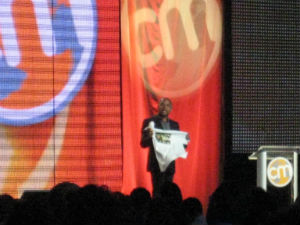 There’s no doubt about it: Coca-Cola is one of the, if not THE most recognized brand in the world. At the afternoon keynote presentation at Content Marketing World 2013 Day 1, the crowd was lucky enough to hear one of Coke’s most important marketing strategists – Jonathan Mildenhall – who is the Vice President of Global Creative and also one of the rockstars in our Content Marketing Rocks! eBook.
There’s no doubt about it: Coca-Cola is one of the, if not THE most recognized brand in the world. At the afternoon keynote presentation at Content Marketing World 2013 Day 1, the crowd was lucky enough to hear one of Coke’s most important marketing strategists – Jonathan Mildenhall – who is the Vice President of Global Creative and also one of the rockstars in our Content Marketing Rocks! eBook.
Their term: liquid storytelling.
Every day, Coke’s team is tasked with brainstorming ways of how they can tell the story of their brand, through the eyes of their consumers, and they constantly find marketing tactics that no one has the bravery to do before. Mildenhall’s keynote presentation was filled with examples of how his team really listens to the consumer in strategizing how to market to them through storytelling, and thus insert the brand into consumer conversations. Are you telling stories with your marketing for your consumers?
See if you can learn any ideas for your company (potentially with a smaller budget, and on a smaller scale) from Coke’s case studies.
“The voice of the consumer is the heart of the brand.”
Drive liquid and linked marketing: When asked to embody Coke Zero, they came up with the concept of creating video to show how a dance goes viral. This resonates with their target audience as a story they’re very familiar with. The entire campaign was based around the video showcasing the story of the teen who started it all.
Make a case for change: When Australians weren’t drinking enough Coke, the company connected with them by placing popular names in the country on the bottles and cans, and inviting consumers to create their own. This tactic wasn’t just demonstrated at the point of purchase, but recruited “Kates” and “Kylies” to appear in everything from billboards to digital ads – you and your friends were up in lights and invited to share a Coke. Your consumer is engaged solely because it’s their name – and then their image that the brand is specifically speaking to. Everyone wants to be famous, and the campaign result notably increased sales of the beverage in that country.
Evolve in your storytelling: During the 2012 Super Bowl, more than half a million people watched the iconic Coca-Cola Polar Bears watch the game. They each reacted when their respective team scored, motioned along with their favorite commercials, and slept during the competitor ads. Coke’s consumers watched the bears for an average of 28 minutes per stream, making the consumer engaged for a much longer time than any traditional advertising. This tactic worked because not only had it never been done before, but it captivated the audience who watches the game “for the ads.”
Build social purpose into your storytelling: Coca-Cola set up a Coke Machine in India and Pakistan that contained a webcam and interactive video stream between the two. Those who approached could wave, “touch” hands, and bring together people from the two countries. Not only is this an innovative approach, but again it involves the interaction of your fans who can tell your story for you – and has a social purpose of connecting your consumers with each other, creating community in a new, virtual way.
Apply the 70/20/10 investment principle for liquid content: 70% is safe content, 20% is innovating on what works well, and 10% is high-risk. For Fanta, Coke created a commercial in Brazil where people playing in the street attempted to keep a giant orange ball in the air. To expand on this commercial and reach teens, they created a game that users could play online with the same objective. It bombed. Lesson learned – they turned around to create something completely new – a groundbreaking graphic, interactive novel that was widely read, interacted with, and played as a game by the target teen audience. It was much more quality, shareable, user content that resonated well.
In summary, Coca-Cola’s goal is to obtain a share of popular culture – by executing strategies that position them as a groundbreaking, storytelling brand. Every day they will strive for something bigger and better because Coca-Cola’s C-suite understands that in marketing, in the end:
“If you don’t have room to fail, you don’t have room to grow.”


